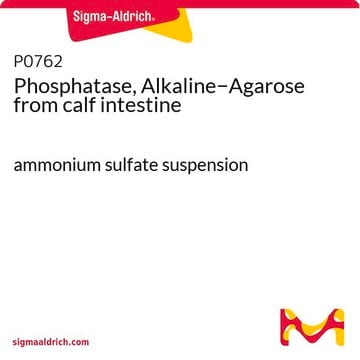API-RO
Roche
Alkaline Phosphatase (AP)
grade I, from calf intestine
Synonym(s):
AP, Alkaline Phosphatase
Sign Into View Organizational & Contract Pricing
All Photos(1)
About This Item
Recommended Products
biological source
bovine (calf) intestine
Quality Level
form
suspension
packaging
pkg of 1,500 U (10108138001)
pkg of 7,500 U (10108146001)
manufacturer/tradename
Roche
optimum pH
8.0-10.5
absorption
7.6 at 278 nm (10 mg AP/ml)
storage temp.
2-8°C
General description
At 37 °C with 4-nitrophenyl phosphate as the substrate, and diethanolamine as the buffer (400 U/mg at 25 °C with 4-nitrophenyl phosphate as the substrate, and glycine as the buffer)
Orthophosphoric-monoester phosphohydrolase (alkaline optimum)
Alkaline phosphatase catalyzes the removal of phosphate group from various compounds that are phosphorylated. It hydrolyzes 5′-monophosphate groups from both DNA and RNA. It can also hydrolyze 5′-diphosphate and 5′-triphosphate groups from RNA.
Alkaline phosphatase catalyzes the removal of phosphate group from various compounds that are phosphorylated. It hydrolyzes 5′-monophosphate groups from both DNA and RNA. It can also hydrolyze 5′-diphosphate and 5′-triphosphate groups from RNA.
Specificity
Heat inactivation: AP activity is destroyed irreversibly by incubating the enzyme at 65 °C.
Denaturation is dependent on protein concentration - using less than 10 U/ml (0.1 mol/l glycine buffer, pH 10.5, 1 mmol/l MgCl2 and 0.1 mmol/l ZnCl2), AP is inactivated by a 10 minutes incubation at 65 °C.
Denaturation is dependent on protein concentration - using less than 10 U/ml (0.1 mol/l glycine buffer, pH 10.5, 1 mmol/l MgCl2 and 0.1 mmol/l ZnCl2), AP is inactivated by a 10 minutes incubation at 65 °C.
Application
Selective cleavage of terminal phosphate groups from oligonucleotides and in protein nucleotide exchange and deliverance. It has also been used to phosphorylate samples to distinguish between phosphate moieties present as phosphorylated glycans and phosphorylated amino acid residues.
Quality
Contaminants: <0.0004% PDE, <0.004% ADA and A-5-MP deaminase, each
Sequence
AP is a dimer of identical or nearly identical subunits; each of which contains 2 molecules of Zn2+ , one tightly bound and necessary for structural stability, the other loosely bound and required for caytalytic activity. The active site contains a reactive serine.
In some mammals (e.g., humans), there are at least 3 distinguishable isoenzymes: the intestinal, the placental and the form found in bone/liver/kidney.
In some mammals (e.g., humans), there are at least 3 distinguishable isoenzymes: the intestinal, the placental and the form found in bone/liver/kidney.
Unit Definition
Unit Conversion: 1 Roche unit (tested at +25 °C) corresponds to ~2 to 2.5 Sigma units (tested at +37 °C).
AP activity is not expressed in Armstrong units; a conversion factor for international units is not known.
Approx. 3.8 U (grade I AP) or 4.0 U (grade II AP) [+37 °C, 4-NPP as substrate, diethanolamine as buffer, pH 9.8] = 1 U [+25 °C, 4-NPP as substrate, glycine as buffer, pH 10.5].
Biochemica Information. 87 (grade I AP) :
1.0 U [+37 °C, QC assay conditions] = 0.79 U [+30 °C, QC assay conditions] = 0.57 U [+25 °C, QC assay conditions]
AP activity is not expressed in Armstrong units; a conversion factor for international units is not known.
Approx. 3.8 U (grade I AP) or 4.0 U (grade II AP) [+37 °C, 4-NPP as substrate, diethanolamine as buffer, pH 9.8] = 1 U [+25 °C, 4-NPP as substrate, glycine as buffer, pH 10.5].
Biochemica Information. 87 (grade I AP) :
1.0 U [+37 °C, QC assay conditions] = 0.79 U [+30 °C, QC assay conditions] = 0.57 U [+25 °C, QC assay conditions]
Physical form
Suspension in 3.2 M ammonium sulfate solution, 1 mM MgCl2, 0.1 mM ZnCl2, pH approximately 7
Preparation Note
- Activator: Divalent metal ions (Mg2+, Co2+, Mn2+)
- Amino alcohols (2-amino-2-methyl-1-propanol, diethanolamine)
Note that high concentrations of amino alcohols can as well act as competitive inhibitors (e.g., monoethanolamine in diethanolamine).
Storage conditions (working solution): The suspension is offered at a c= approx. 5 mg/ml.
If this suspension is diluted only 5 to 10-fold with further 3.2 M ammonium sulfate solution, 1 mM MgCl2, 0.1 mM ZnCl2, pH approx. 7, we would expect from general experience that a stability for some weeks might be given provided it is stored at 4 °C (no guarantee!).
Other Notes
For life science research only. Not for use in diagnostic procedures.
Storage Class Code
12 - Non Combustible Liquids
WGK
WGK 1
Flash Point(F)
does not flash
Flash Point(C)
does not flash
Certificates of Analysis (COA)
Search for Certificates of Analysis (COA) by entering the products Lot/Batch Number. Lot and Batch Numbers can be found on a product’s label following the words ‘Lot’ or ‘Batch’.
Already Own This Product?
Find documentation for the products that you have recently purchased in the Document Library.
Customers Also Viewed
METHOD SUMMARY
Stephanie Ketcham
Biotechniques, 117-123 (2017)
Brian M Zeglis et al.
Nature protocols, 2(2), 357-371 (2007-04-05)
This protocol describes the syntheses and applications of two metallointercalators, Rh(bpy)2(chrysi)3+ and Rh(bpy)2(phzi)3+, that target single base mismatches in DNA. The complexes bind mismatched DNA sites specifically and, upon photoactivation, promote strand scission neighboring the mismatch. Owing to their high
O Brenna et al.
The Biochemical journal, 151(2), 291-296 (1975-11-01)
A crude preparation of alkaline phosphatase (EC 3.1.3.1) from calf intestinal mucosa was purified by affinity chromatography on Sepharose-bound derivatives of arsanilic acid, which was found to be a competitive inhibitor of the enzyme. Three biospecific adsorbents were prepared for
Raphael Gasper et al.
Small GTPases, 1(3), 133-141 (2011-06-21)
The Ras family is the largest and most diverse sub-group of Ras-like G proteins. This complexity is further increased by the high number of regulatory Guanine nucleotide Exchange Factors (GEFs) and GTPase Activating Proteins (GAPs) that target specific members of
Our team of scientists has experience in all areas of research including Life Science, Material Science, Chemical Synthesis, Chromatography, Analytical and many others.
Contact Technical Service






